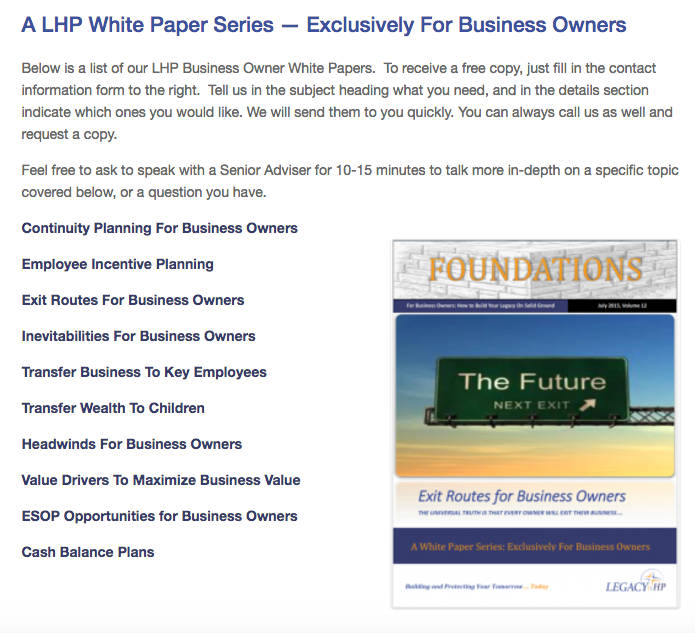When we advisors think of family-business transfers, we tend to focus on family-specific challenges. Of course, some challenges are common to all successful owner exits. In this article we briefly look at three of these universal challenges, but from a family-business transfer perspective: 1) a capable successor, 2) a prepared business and 3) a ready owner.
A Capable Successor
For a significant time period prior to the owner's departure, the child (or children) designated as the successor has demonstrated both the capability and the willingness to run the business.
How do you assess whether a child is capable of, and willing to, run and own a business? An information indicator is two-fold: 1) the owner's willingness to take extended vacations without calling the business "just to check up on things," and 2) learning from that call that "things" are just fine.
While this test works fairly well in a small shop for a fairly limited period of time, it is not sufficient for larger companies over long periods of time. The owner's advisor team must help the parent/owner prepare the successor child for future responsibilities as the owner would any key employee by doing the following: increase levels of responsibility and measure progress, provide ongoing education, delegate authority and offer leadership training. If you are the owner's lead advisor, you should be able to call on experience, specialized consultants to support these efforts. In future articles we will discuss the importance of developing a team of diverse professionals who support your Exit Planning efforts with owners.
A Prepared Business
All too often we blame the children for family-transfer disasters when most of the blame, if it were to be apportioned fairly, rests on the current owners—the parents (and by association us . . . their advisors!).
As with any other exit path, a successful exit is impossible if the current ownership has failed to create transferable value before leaving the business. The value driver with the biggest impact on transferable value is the existence of next-level management who will remain with the business as it is transferred to new ownership.
Next-level management in family-business transfers includes, of course, children who are fully capable of moving the business forward without the parents’ involvement. But it can also involve capable, non-family members of management if the children aren’t ready to take over when the owner is ready to exit.
Part of Exit Planning for a family business is to ensure that it has long-term viability independent of the parents’ continued involvement. This may be best accomplished by creating plans (such as non-qualified deferred compensation plans tied to the owner’s exit date) to encourage and motivate non-family management to remain with the company during and after the ownership transition.
A Ready Owner
Child(ren) must be ready, willing and able, but so must owners be ready and willing for the transition. We are all aware of those owners who refuse to let go of control even though their now 55-year-old child has been running the business successfully for years. Avoid this problem at the outset of planning—the goal setting stage—by asking owners questions such as:
- How do you envision your future without the business?
- What has to happen for you to transfer ownership and control to your designated child/ren?
A Prescription for Hesitant Owners
Owner hesitancy can come from a fear of not knowing what they would do without the business. If the owner is not sure how to answer or hesitates, you can suggest several avenues:
- Provide the opportunity for your client to talk to other owners who have exited.
- Suggest that they can stay active in the business even after they transfer control of it (and after achieving their financial security and other goals, of course). If that appeals to an owner, recommend that the owner and incoming owners create job descriptions and agree upon their salaries.
- Encourage your client to try a few “low-cost probes” by becoming active before their exit in activities that they think will give their life meaning, significance, happiness and fulfillment after their exit. Encourage them to keep experimenting with activities until they are confident that their lives will be enhanced, not diminished, by exiting.
The recommendations in this article require you to be proactive. You must reach out to your owner-clients. They will likely never reach out to you—they don’t know who to ask for advice or what advice to ask for.
This article, and all those in this series on family business transition planning, is intended to provide you with insights on a planning approach to help your clients. In next week’s article we continue our overview of family business planning concepts.
Take care and have a good day,
Michael
ABOUT LEGACYHP: Our passion is our mission -- To position our clients into a positive, energized, posture -- within your businesses and within your lives -- So that you manage change confidently, take decisive action, and enjoy life's journey Today... while you enjoy building your Legacy for Tomorrow.
Notice: The information contained in this article is general in nature and is not legal, tax or financial advice. For information regarding your particular situation, contact an attorney or a tax or financial advisor. The information in this newsletter is provided with the understanding that it does not render legal, accounting, tax or financial advice. In specific cases, clients should consult their legal, accounting, tax or financial advisor. This article is not intended to give advice or to represent our firm as being qualified to give advice in all areas of professional services. Exit Planning is a discipline that typically requires the collaboration of multiple professional advisors. To the extent that our firm does not have the expertise required on a particular matter, we will always work closely with you to help you gain access to the resources and professional advice that you need.



